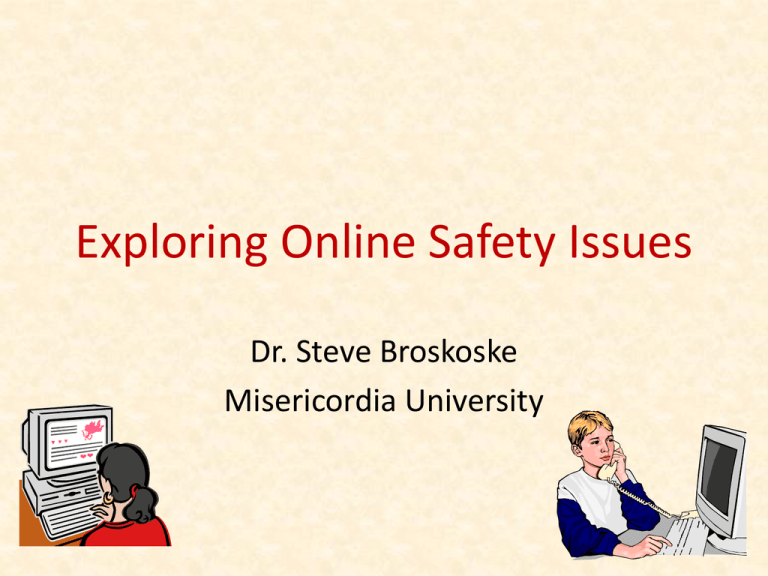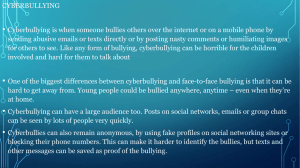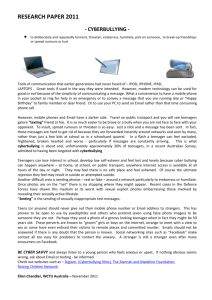Exploring Online Safety Issues
advertisement

Exploring Online Safety Issues Dr. Steve Broskoske Misericordia University Outline • • • • • Being found online. Internet “lingo”. Sexting. Cyberbullying. Identity theft. Introduction / Background Internet Usage • According to the U.S. Department of Education: – 23% of nursery school children in the U.S. use the Internet. – 32% of kindergartners go online. – By high school, 80% of children use the Internet. Remember: Children Can Get Online Almost Anywhere • Home computer, or one at a friend’s home, library, or school. • Wireless “hotspots” at coffee shops, bookstores, restaurants. • Internet-enabled, video-game systems (compete against and chat with players around the world). • Cell phone wireless connections (surf the Web, exchange messages, photographs, and short videos). Internet Safety Is Needed • Threats that affect children: – Many of the old threats are still out there. – Many threats are updated & enhanced to work on new technology. – There are new threats that a few years ago no one could even imagine. Recipe for Trouble Curious, sometimes precocious children Anonymity for users Technology Teacher and guardian lack of technology knowledge Innocence Ubiquitous communication What Can/Must We Do? • As teachers of children, we must: 1. Educate children on dangers associated with online communication. 2. Monitor children’s behavioral changes. 3. Stay up-to-date with online threats. Can You Be Found Online? Can You Be Found? 1. Imagine that you just have a name and a state. • Try to find a phone number and address for this name. 2. Pretend that you only have a phone number. • Try locating a name for this person. Anywho.com Protect Children • • • • Place family PC in a public place (vs. in a child’s room). Don’t allow children to be online late at night without your supervision. If something looks strange, there might be something wrong: investigate! Be aware of the “lingo.” Knowing the “Lingo” Internet “Lingo” that Every Teacher Must Know • Children and adults alike use acronyms (text shortcuts) because it saves time and typing (e.g., BRB, TTFN). • Acronyms can also be used to conceal messages from teachers and guardians. Internet Lingo A: Interacting with Guardians • • • • • • • • • MOS POS P911 PAL PAW PRW PIR CD9 KPC Mom Over Shoulder Parent Over Shoulder Parent Alert Parents Are Listening Parents Are Watching Parents Are Watching Parent In Room Code 9 (Parents Are Around) Keeping Parents Clueless Internet Lingo B: Getting Acquainted • • • • • • • MOOS MOSS ADR ASL RU/18 WYCM LMIRL Member(s) Of The Opposite Sex Member(s) Of The Same Sex Address Age/Sex/Location Are You Over 18? Will You Call Me? Let's Meet In Real Life Internet Lingo C: Getting Better Acquainted • • • • • • • • • KFY/K4Y RUH 1174 SorG GYPO GNOC NIFOC IMEZRU IWSN Kiss For You Are You Horny? Nude club Straight or Gay Get Your Pants Off Get Naked On Cam Nude In Front Of The Computer I Am Easy, Are You? I Want Sex Now Sexting Sexting • Sexting (sex and texting) is the act of sending sexually explicit messages or photos electronically, primarily between cell phones. Children have not changed. Communication opportunities have. How Do Teens View Sexting? • Children (especially teenagers) view sexting as a modern form of flirting, or as a lead-in to sexual activity. Dating Advice from David Wygant What Children Do Not Realize • A social danger with sexting is that material can be very easily and widely disseminated, over which the originator has no control. can result in widespread dissemination What Children Do Not Realize • Sexting can involve them being treated as adults in sexually-based legal situations. • Sexting can potentially label them forever as sexual predators. How Serious is Sexting? • Child pornography charges were brought against six teenagers (Greensburg, Pennsylvania) in January, 2009 after three girls sent sexually explicit photographs to three male classmates Our legal system has not yet determined how to treat these cases. How Serious is Sexting? • A teenage boy (Fort Wayne, Indiana) was indicted on felony obscenity charges for allegedly sending a photo of his private parts to several female classmates. • Locally: Wyoming County DA threatened to charge 20 Tunkhannock teens with felony charges for circulating nude photos (sexting). How Serious is Sexting? • Two southwest Ohio teenagers were charged with contributing to the delinquency of a minor, a first-degree misdemeanor, for sending or possessing nude photos on their cell phones of two 15-year-old classmates. How Serious is Sexting? • A 17-year-old girl (Castalia, Ohio) allegedly sent nude pictures of herself to her former boyfriend. • The two got into a fight, and the pictures started circulating around the high school. • The girl was charged with being an “unruly child” based on her juvenile status. Legal Reaction • Vermont: Introduced a bill in April, 2009 to legalize the consensual exchange of graphic images between two people 13 to 18 years old. Passing along such images to others would remain a crime. Legal Reaction • Ohio: Proposed a law that would reduce sexting from a felony to a first degree misdemeanor, and eliminate the possibility of a teenage offender being labeled a sex offender for years. Legal Reaction • Utah: Lawmakers lessened the penalty for sexting for someone younger than 18 from a felony to a misdemeanor. Pennsylvania • Miller v. Skumanick: – DA in Tunkhannock (Skumanick) told parents they could either enlist their kids in an education program or have the teens face felony charges of child pornography. – ACLU sued Skumanick on behalf of a girl threatened with prosecution. – Third Circuit ruled for the girl, finding that Skumanick was barred from filing charges without evidence that she had engaged in distributing the picture of herself. QUIZ: How Much Do You Know? • How much do you know about abductions? Let’s take a brief quiz. National Center for Missing & Exploited Children www.missingkids.com Question Abduction Survey 1. How old are the most common victims of abduction and exploitation? a) Five years old. b) Infants. c) Teenagers. Answer Abduction Survey 1. How old are the most common victims of abduction and exploitation? – (c) Teenagers. • Teenagers (especially girls 12-19) are the most victimized segment of the U.S. population, victimized at a rate 84% higher than the general public. Question Abduction Survey 2. Who is the most likely individual to abduct your child? a) Someone they know. b) Someone they don't know. Answer Abduction Survey 2. Who is the most likely individual to abduct your child? – (a) Someone they know. • According to U.S. Department of Justice: – 354,600 children are kidnapped by a family member. – Up to 5,000 are abducted by people who have at least some acquaintance with the child. – Random abduction of children by strangers are estimated at 200 in the U.S. each year. Question Abduction Survey 3. What is one of most important things parents can do to help keep your children safer? a) Have their fingerprints taken by police. b) Have their photographs taken at least annually. c) Supervise them and talk to them early and regularly about their safety. Answer Abduction Survey 3. What is one of most important things you can do to help keep your children safer? – (c) Supervise them & talk to them. • Although it is important to plan for an emergency, nothing is more important than talking with a child and creating an atmosphere in your own home where they feel safe coming to you and confiding information about an uncomfortable experience. What Can We Do? Teachers: Talk to teenage children about the dangers of sexting. Teachers: Teach kids to never post their cell phone number anywhere online. Parents: Create rules about appropriate use of phones. Set limits, including to whom and when they can talk. Parents: Review phone records for any unknown numbers and late-night calls. Cyberbullying What is Cyberbullying? Cyberbullying occurs “when the Internet, cell phones, or other devices are used to send or post text or images intended to hurt or embarrass another person.” National Crime Prevention Council Cyberbullying • Cyberbullying can be simple… – Continuing to send e-mail to someone who has said he/she wants no further contact. • Or involved… – Sending threatening and harassing emails, instant messages, or text messages to the victim. • Or even more involved… Cyberbullying • Cyberbullies may: – Disclose victims’ personal data. – Pose as the victim and post false material. – Post rumors or gossip and instigate others to dislike or gang up on the target. – Post an edited photo of a victim. Cyberbullying Stats • A survey of 1,247 (age 14-24) found: – 50% have experienced digitally abusive behavior, with older teens aged 18-24 (52% vs. 47%) and females more likely to be targeted (53% vs. 42%) – 45% report witnessing people being mean to each other on social networking sites. AP-MTV survey, (Sept. 2009) Cyberbullying Stats – 56% bullied reported they were “very” or “extremely” upset. – Bullied are twice as likely to have received treatment from a mental health professional. – Bullied are nearly 3 times more likely to consider dropping out of school! – Only about half (51%) of respondents reported they have thought the idea that things they post online could come back to hurt them later. AP-MTV survey, (Sept. 2009) Cyberbullying Stats • According to another survey, 58% of respondents have not told their parents or an adult about something mean or hurtful that happened to them online. • A Canadian study of middle-schoolers found that 41% did not know the identity of the perpetrators. Why is Cyberbullying Effective? • Cyberbullies can remain anonymous. • Cyberbullies do not face their targets. It takes little energy or courage to express hurtful comments using a keyboard. • Cell phones are constantly turned on. Cyberbullying penetrates the walls of a home, traditionally a place where victims could seek refuge from other forms of bullying. Legal Response • The California state legislature passed one of the first laws in the country to deal directly with cyberbullying. This law took effect January 1, 2008. – The legislation (Assembly Bill 86 2008) gives school administrators the authority to discipline students for bullying others offline or online. Legal Response • Legislation geared at penalizing cyberbullying has been introduced in a number of states. – Including New York, Missouri, Rhode Island, and Maryland. • At least seven states passed laws against digital harassment. Legal Response • In June, 2008, representatives from California and Missouri proposed federal legislation that would criminalize acts of cyberbullying. – The proposed federal law would make it illegal to use electronic means to “coerce, intimidate, harass or cause other substantial emotional distress.” Harmful Effects of Cyberbullying • Research has demonstrated that victims: Have lower self-esteem. Exhibit a variety of emotional responses (cyberbullying back, feeling scared, frustrated, or angry). May begin to avoid friends and activities (often the intention of the cyberbully). • Some victims become depressed and experience increased suicidal ideas. Pennsylvania Action • Governor Ed Rendell required all schools to put a cyber bullying disciplinary code in place by January, 2009. • Attorney General’s office has a training program available for schools. Harmful Effects of Cyberbullying • Megan Meier (13 year-old from Missouri) – After opening an account on MySpace, Meier received a message from Lori Drew, who used a fabricated account attributed to a 16year-old boy, Josh Evans. Harmful Effects of Cyberbullying • After a time, “Josh” said he did not want to talk with her any more because of the gossip he had heard about her, gossip that “everybody knows.” • Megan committed suicide. • Motive: Retaliation for gossip Megan allegedly spread about Drew’s daughter. Harmful Effects of Cyberbullying • Jessie Logan (18-year-old from Cincinnati) • Sexted a nude picture of herself, that was forwarded to nearly everyone in her high school. • Jessie’s grades plummeted and she started skipping school. • On July 3, 2008, Jessie attended the funeral of a boy who had committed suicide. She went home and killed herself. Young people are reluctant to tell an authority figure about cyberbullying. Identity Theft Are You At Risk for Identity Theft? • What are you carrying in your wallet? • Is your mail safe? • Do you shred information before throwing it in the trash? • When someone calls on the phone… – Name or any personally identifying info.? Internet Safety • Federal Trade Commission • www.ftc.gov • Offers: – Explanation in detail. – Resources. – Great information! Questions about FTC Video • How do thieves steal your identity? • What can you do to deter identity theft? • If you are a victim of identity theft, what do you do? • How can you monitor your safe identity? Identity Theft • Identity theft occurs when someone uses your personally identifying information to commit fraud or other crimes. – Name. – Social Security number. – Credit card number. – Financial institution information. Identity Theft • Sometimes costs hundreds of dollars and many days to repair damage to your good name and credit record. – Denied loans for education, housing or cars because of negative information on their credit reports. – In rare cases, people have been arrested for crimes they did not commit. How Does Identity Theft Occur? • Old-Fashioned Stealing: – Wallets and purses. – Mail: bank and credit card statements, preapproved credit offers, new checks, tax information. – Personnel records stolen or employees bribed. • Pretexting: Using false pretenses to obtain personal information from financial institutions, telephone companies, and other sources. How Does Identity Theft Occur? • Dumpster Diving: Rummage through trash looking for bills or other paper with your personal information on it. • Skimming: Steal credit/debit card numbers by using a special storage device when processing your card. • Phishing: Pretend to be financial institutions or companies and send spam or pop-up messages to get you to reveal your personal information. • Changing Your Address: Divert your billing statements to another location by completing a change of address form. To Avoid Identity Theft 1. Never give out personally identifying information to anyone (except for authorities and people you trust). 2. Always shred mail that contains your name, address, and other personally identifying information. 3. Protect against spyware. 4. Check your credit report periodically. Spyware • “Spying” software placed on your PC when you visit Web sites. • Sometimes for marketing, sometimes for theft. Ad-Aware at LavaSoft.com Find Ad-Aware at Download.com Review • • • • • Being found online. Internet “lingo”. Sexting. Cyberbullying. Identity theft.






